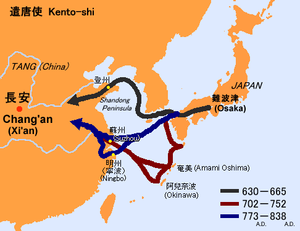جزر ريوكيو
لغات ريوكيو: Ruuchuu (琉球/ルーチュー?) اللغة اليابانية: Nansei-shotō (南西諸島?, الجزر الجنوبية الغربية) Ryūkyū-shotō (琉球諸島?, جزر ريوكيو)[1] | |
|---|---|
 موقع جزر ريوكيو | |
 | |
| الجغرافيا | |
| الموقع | على الحدود بين بحر الصين الشرقي وبحر الفلپين |
| الإحداثيات | 26°30′N 128°00′E / 26.5°N 128°E |
| إجمالي الجزر | 100+ |
| الجزر الرئيسية | أوكيناوا، أمامي |
| المساحة | 4,642.11 km2 (1,792.33 sq mi) |
| أعلى منسوب | 1,936 m (6٬352 ft) |
| أعلى نقطة | جبل Miyanoura-dake |
| الإدارة | |
Japan | |
| السكان | |
| اسم المواطن | Ryukyuans |
| التعداد | 1,550,161 (2005) |
| الكثافة السكانية | 333٫93 /km2 (864٫87 /sq mi) |
| الجماعات العرقية | ريوكيو، يابانيون |
جزر ريوكيو /riˈuːkjuː/[2] (琉球諸島, Ryūkyū-shotō),[3] تُعرف في اليابانية بإسم جزر نانسـِيْ (南西諸島, Nansei-shotō, lit. "الجزر الجنوبية الغربية") وتُعرف أيضاً بإسم قوس ريوكيو (琉球弧, Ryūkyū-ko)، هي سلسلة من الجزر اليابانية التي تمتد إلى الجنوب الغربي من كيوشو إلى تايوان: the Ōsumi, Tokara, Amami, Okinawa, and Sakishima Islands (further divided into the Miyako and Yaeyama Islands), with Yonaguni the southernmost. The larger are mostly high islands and the smaller ones are mostly coral islands. أكبر الجزر هي أوكيناوا.
The climate of the islands ranges from humid subtropical climate (Köppen climate classification Cfa) in the north to tropical rainforest climate (Köppen climate classification Af) in the south. Precipitation is very high, and is affected by the rainy season and typhoons. Except the outlying جزر دايتو، the island chain has two major geologic boundaries, the Tokara Strait between the Tokara and Amami Islands, and the Kerama Gap between the Okinawa and Miyako Islands. The islands beyond the Tokara Strait are characterized by their coral reefs.
The Ōsumi and Tokara Islands, the northernmost of the islands, fall under the cultural sphere of the Kyushu region of Japan; the people are ethnically Japanese and speak a variation of the Kagoshima dialect of Japanese. The Amami, Okinawa, Miyako, and Yaeyama Islands have a native population collectively called the Ryukyuan people, named for the former Ryukyu Kingdom that ruled them. The varied Ryukyuan languages are traditionally spoken on these islands, and the major islands have their own distinct languages. In modern times, the Japanese language is the primary language of the islands, with the Okinawan Japanese dialect prevalently spoken. The outlying Daitō Islands were uninhabited until the Meiji period, when their development was started mainly by people from the جزر إيزو south of Tokyo, with the people there speaking the Hachijō language.
Administratively, the islands are divided into Kagoshima Prefecture (specifically the islands administered by Kagoshima District, Kumage Subprefecture/District, and Ōshima Subprefecture/District) in the north and Okinawa Prefecture in the south, with the divide between the Amami and Okinawa Islands, with the Daitō Islands part of Okinawa Prefecture. The northern (Kagoshima) islands are collectively called the Satsunan Islands, while the southern part of the chain (Okinawa Prefecture) are called the Ryukyu Islands in Japanese.
تجميعات الجزر

الأسماء وامتداداتها
جزر نانسـِيْ
Nansei-shotō (南西諸島?) is the official name for the whole island chain in Japanese.
ريوكيو
The name of Ryūkyū (琉球?) is strongly associated with the مملكة ريوكيو,[4] a highly centralized kingdom that originated from the Okinawa Islands and subjected the Miyako and Yaeyama Islands, and the Amami Islands for some time. The name is generally considered outdated in Japanese although some entities of Okinawa still bear the name, such as the local national university.
أوكيناوا
Okinawa (沖縄?) is originally a native name for the largest island in the island chain.
الجزر الجنوبية
التاريخ
الجزر الجنوبية لليابان القديمة

تانىگاشيما تحت حكم عشيرة تانىگاشيما
جزر أوكيناوا
 مقالة مفصلة: جزر أوكيناوا
مقالة مفصلة: جزر أوكيناوا
السكان
البيئة
ياكوشيما
أمامي، أوكيناوا، ميياكو، و يائياما

انظر أيضاً
المراجع
الهامش
- ^ Tsuneyoshi, Ukita (1993). Nihon-dai-chizuchō (Grand Atlas Japan). Heibonsha. ISBN 978-4-582-43402-6.
- ^ قالب:OED
- ^ Tsuneyoshi, Ukita (1993). Nihon-dai-chizuchō (Grand Atlas Japan). Heibonsha. ISBN 4-582-43402-9.
- ^ "(りゅうきゅう〔リウキウ〕【琉球】)". Daijisen dictionary / Yahoo Japan. Retrieved 2007-05-06.
المصادر
- Kang, David C. (2010). East Asia Before the West: Five Centuries of Trade and Tribute. New York : Columbia University Press. ISBN 9780231153188 ISBN 9780231526746 ISBN 0231526741; OCLC 562768984
- Nussbaum, Louis-Frédéric and Käthe Roth (2005). Japan encyclopedia. Cambridge, MA: Harvard University Press. ISBN 978-0-674-01753-5; OCLC 58053128
- This article incorporates text from the 1878 edition of the Globe Encyclopaedia of Universal Information, a work in the public domain
وصلات خارجية
- A Brief History of the Uchinanchu (Okinawans)
- الأرشيف الوطني لليابان: Ryukyu Chuzano ryoshisha tojogyoretsu, scroll illustrating procession of Ryuku emissary to Edo, Hōei 7 (1710)
- Historic maps in the Perry-Castañeda Library Map Collection by the Army Map Service, Ryukyu Retto 1:50,000 Series L791, 1943 - 1945
خطأ لوا في وحدة:Authority_control على السطر 278: attempt to call field '_showMessage' (a nil value).
- Pages using gadget WikiMiniAtlas
- Articles with hatnote templates targeting a nonexistent page
- Missing redirects
- Short description is different from Wikidata
- Articles containing Japanese-language text
- Infobox mapframe without OSM relation ID on Wikidata
- Coordinates on Wikidata
- Pages using infobox islands with unknown parameters
- Pages with empty portal template
- جزر ريوكيو
- أرخبيلات اليابان
- المناطق البيئية في اليابان
- مناطق بيئية بحرية
- أرخبيلات المحيط الهادي
- صفحات مع الخرائط



